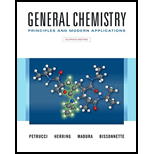
Concept explainers
(a)
Interpretation:
The structure of coordinate complex
Concept introduction:
The coordinate complex is formed by the reaction of metal ions which are electron deficient with ligands which are electron rich. The structure of the coordinate complex is drawn in such a way that metal ion is always placed at the center. The metal ion is than surrounded by ligands which can be negatively charged or neutral. The shape or geometry of the complex can be determined by number of ligands surrounded by a metal ion.
(b)
Interpretation:
The structure of coordinate complex
Concept introduction:
The coordinate complex is formed by the reaction of metal ions which are electron deficient with ligands which are electron rich. The structure of the coordinate complex is drawn in such a way that metal ion is always placed at the center. The metal ion is than surrounded by ligands which can be negatively charged or neutral. The shape or geometry of the complex can be determined by number of ligands surrounded by a metal ion.
(c)
Interpretation:
The structure of coordinate complex
Concept introduction:
The coordinate complex is formed by the reaction of metal ions which are electron deficient with ligands which are electron rich. The structure of the coordinate complex is drawn in such a way that metal ion is always placed at the center. The metal ion is than surrounded by ligands which can be negatively charged or neutral. The shape or geometry of the complex can be determined by number of ligands surrounded by a metal ion.
(d)
Interpretation:
The structure of coordinate complex
Concept introduction:
The coordinate complex is formed by the reaction of metal ions which are electron deficient with ligands which are electron rich. The structure of the coordinate complex is drawn in such a way that metal ion is always placed at the center. The metal ion is than surrounded by ligands which can be negatively charged or neutral. The shape or geometry of the complex can be determined by number of ligands surrounded by a metal ion.
(e)
Interpretation:
The structure of coordinate complex
Concept introduction:
The coordinate complex is formed by the reaction of metal ions which are electron deficient with ligands which are electron rich. The structure of the coordinate complex is drawn in such a way that metal ion is always placed at the center. The metal ion is than surrounded by ligands which can be negatively charged or neutral. The shape or geometry of the complex can be determined by number of ligands surrounded by a metal ion.
Want to see the full answer?
Check out a sample textbook solution
Chapter 24 Solutions
Mastering Chemistry With Pearson Etext -- Standalone Access Card -- For General Chemistry: Principles And Modern Applications (11th Edition)
- What type of isomerism is shown by [CO(NH3)5ONO]Cl2? (ii) On the basis of crystal field theory, write the electronic configuration for d4 ion if A0 < P. (iii) Write the hybridization and shape of [Fe(CN)6]3-. (Atomic number of Fe — 26)arrow_forwardWhat is a Chelate ligand? Give one example.arrow_forwardI want to make a table for each complex and put the oxidation number, consistency number, shape and hybridization Example:Cu(CN)2−,Cu(NH3)2+,Hg(CN)2,[CuCl2]−arrow_forward
 Chemistry: An Atoms First ApproachChemistryISBN:9781305079243Author:Steven S. Zumdahl, Susan A. ZumdahlPublisher:Cengage Learning
Chemistry: An Atoms First ApproachChemistryISBN:9781305079243Author:Steven S. Zumdahl, Susan A. ZumdahlPublisher:Cengage Learning ChemistryChemistryISBN:9781305957404Author:Steven S. Zumdahl, Susan A. Zumdahl, Donald J. DeCostePublisher:Cengage Learning
ChemistryChemistryISBN:9781305957404Author:Steven S. Zumdahl, Susan A. Zumdahl, Donald J. DeCostePublisher:Cengage Learning
 Chemistry: Principles and ReactionsChemistryISBN:9781305079373Author:William L. Masterton, Cecile N. HurleyPublisher:Cengage Learning
Chemistry: Principles and ReactionsChemistryISBN:9781305079373Author:William L. Masterton, Cecile N. HurleyPublisher:Cengage Learning Principles of Modern ChemistryChemistryISBN:9781305079113Author:David W. Oxtoby, H. Pat Gillis, Laurie J. ButlerPublisher:Cengage Learning
Principles of Modern ChemistryChemistryISBN:9781305079113Author:David W. Oxtoby, H. Pat Gillis, Laurie J. ButlerPublisher:Cengage Learning




